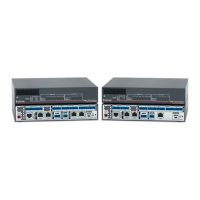DMP 128 FlexPlus • Configuration Tools 79
Configuring a Macro
1. Click Tools > Configure Macros. The Configure Macros dialog box opens.
2. Select an empty macro slot from the Select Macro drop-down.
3. From the Destination drop-down, select a destination for the macro action.
Choose Local for the local DMP 128 FlexPlus, or Add Destination... for a remote
destination. If choosing Local, proceed to step 4.
NOTE: Macro commands can only be sent to remote destinations via the
LAN/VoIP1 port (V-model only).
a. After selecting Add Destination..., the Edit Remote Destinations dialog
box opens.
b. Complete the form in the dialog box, including username and password, if required.
c. Select Apply to add the device to the drop-down in the Destinations column.
d. Click Close to close the Edit Remote Destinations dialog box.
e. Select the newly created remote destination from the Destination drop-down.
4. From the Action drop-down, select an action to be configured.
• Recall Preset — Recall an existing preset.
• Set Group Gain — Set the level of an existing gain group.
• Group Gain Inc/Dec — Set the increment/decrement values of an existing gain
group.
• Set Group Mute — Mute or unmute an existing mute group.
• Gain — Set the gain of a specific gain block on a specific channel.
• Mute — Mute or unmute a specific gain block on a specific channel.
• Set Phantom Power – Enable or disable phantom power on a specific
Mic/Line input channel.
• Meters On/Off — Enable or disable level meters at the input gain or output
attenuation stages of a specific channel.
• Start Player — Starts a selected player.
• Stop Player — Stops a selected player.
• SIS Command — Type in a single SIS command to perform an action not listed
above (see Remote Communication and Control on page123).
NOTE: Use the W key in place of E and the | (pipe) key in place of }.
• Set Input Format — Specify whether mic/line inputs receive analog signal from the
inputs or digital signal via the Dante network (see
9
in figure 40 on page23).
• Dial Number — Use a specific VoIP line to dial a string.
• Dial Digits — Use a specific VoIP line and line appearance to dial a predetermined
number, such as an extension number or conference pin.
• End Call — End calls on a specific line or all appearances of a VoIP line.
5. Once the action is chosen, up to four additional selections are made available. These
additional selections must be completed in order to proceed to the next macro step.
For example, if Set Group Gain is the selected action, Selection 1 prompts the
selection of a gain group to be affected and Selection 2 determines the gain level of
the selected group.
6. When all of the action selections are configured, a new line appears at the bottom of the
form so another action can be configured.

